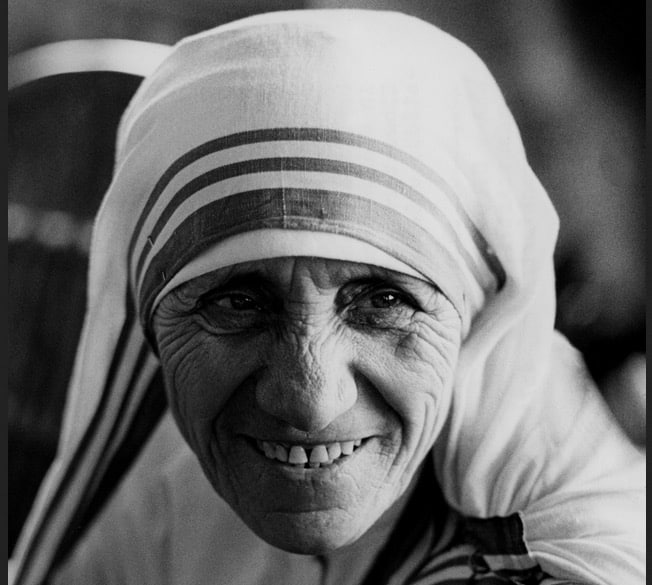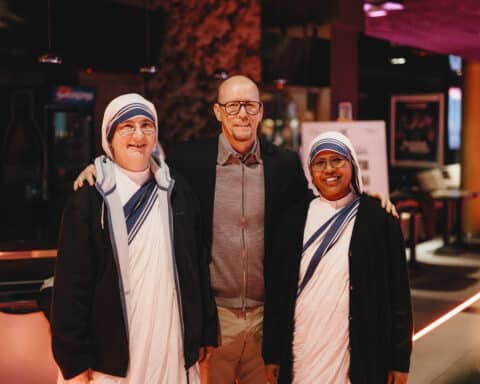“[L]ove makes itself particularly noticed in contact with suffering, injustice and poverty — in contact with the whole historical ‘human condition’ … It is precisely the mode and sphere in which love manifests itself that in biblical language is called ‘mercy.'” — Pope St. John Paul II, Dives in Misericordia, No. 3
If you read that one person in 1950 began an organization in a small part of the world and that 50 years later it had more than 4,000 workers at 610 locations in 123 countries, you might think you were reading about a successful multinational corporation.
These statistics, however, reflect the incredible work of Blessed Mother Teresa of Kolkata and the religious institute she founded, the Missionaries of Charity. The numbers are impressive — and hard to ignore — and they brought a lot of attention to Mother Teresa during her lifetime, both positive and negative. Often, the reaction went hand in hand with the person’s attitude regarding faith: Those who identified as atheists tended to be hostile, while believers tended to be sympathetic. The Catholic Church is unequivocal in its praise of Mother Teresa, not for any human success but for her yielding to God’s will. By beatifying her on Oct. 19, 2003, the Church recommends Mother Teresa as a model disciple of Christ and, more pointedly, as a model of one who received and shared God’s mercy.
Early life
Born Aug. 26, 1910, in Skopje, Macedonia, to Nikola and Drana Bojaxhiu, Mother Teresa, who was born Gonxha Agnes, was surrounded by examples of vibrant faith in her family and parish. Both parents were active in the affairs of the local church. When Nikola died eight years after her birth, Mother Teresa experienced his death within the context of faith. She mourned his death, but because his life continued according to Christian belief, she also continued her journey.
Her mother set the example. Despite the financial strain her husband’s death put on the family, Drana continued to share their food with the poor, even inviting them to dine in the family home. Mother Teresa would practice the same generous charity toward the poor years later.
At 18, Mother Teresa left home for the Loreto convent in Ireland. Less than a year later, she would join the novitiate in Darjeeling, India, the country that would become her home base for the rest of her life. After completing her training, Mother Teresa taught school in Kolkata during the 1930s and ’40s. She made her final profession on May 24, 1937.
Hearing her calling
| Miracle Approved |
|---|
|
Pope Francis on Dec. 17 officially approved a miracle attributed to the intercession of Blessed Teresa of Kolkata, thus paving the way for her canonization.
While the date for her canonization ceremony hasn’t been announced, Archbishop Rino Fisichella, president of the Vatican office organizing the Holy Year of Mercy events, had said it would be Sept. 4, the day before the 19th anniversary of her death, Sept. 5, 1997. The postulator for her sainthood cause, Father Brian Kolodiejchuk of the Missionaries of Charity, said the second miracle involved the healing of a now 42-year-old man in Brazil, who was diagnosed with a viral brain infection and fell into a coma, the priest said in a statement published Dec. 18 by AsiaNews. The man’s wife had spent months praying to Mother Teresa. When he was taken to the operating room Dec. 9, 2008, the surgeon reported that he found the patient awake, free of pain and asking, “What am I doing here?” A Vatican commission voted unanimously in September 2015 that the healing was inexplicable. |
Mother Teresa’s life would take a significant turn in the midst of her teaching vocation. On Sept. 10, 1946, riding a train from Kolkata to Darjeeling for an annual retreat, she experienced what she would later describe as a “call within a call.”
Jesus made known to her that he wanted Mother Teresa to move from the school to the street, where she would provide direct service to the poor. Mother Teresa said Christ wanted her to start an order of nuns that would be dedicated to bring his mercy and love to those excluded from society. Jesus made these things known to her and added, she said, that he would work through her despite her weaknesses and sins.
Mother Teresa responded to Jesus’ requests immediately by petitioning the archbishop of Kolkata, Ferdinand Perier, for permission. His response was not as quick, for he wanted to test its validity. Permission finally came in January 1948, and with the news, Mother Teresa left the convent and went to the streets doing the work for which she became famous: picking up a dying person from the gutter, bathing a child, feeding the hungry. The main goal was always to love Jesus in those who were forgotten by everyone else and to make known to them the love and mercy of God. Twelve women, former teachers and students from St. Mary’s, joined Mother in her work.
On Oct. 7, 1950, the Missionaries of Charity was officially erected as a religious institute for the Archdiocese of Kolkata. Their work and their numbers have continued to grow ever since. And it is well known that Mother Teresa herself received numerous awards from heads of state throughout her lifetime, the most famous being the Nobel Peace Prize in 1979.
Answering critics
What was behind all the success? Mother Teresa’s detractors would say ego and a particular political agenda. Even as late as 2015, readers can find articles passing on the most negative views of Mother Teresa and the Missionaries of Charity. The accusations include using the sick to make herself appear charitable, failing to provide adequate medical treatment, being preoccupied with abortion and contraceptives, and providing cover — by her good reputation — for unsavory politicians and businessmen who rubbed shoulders with her. All of these accusations have been shown to have no merit, so why pay attention to them at all?
One reason is that no one, not even Mother Teresa, is above criticism. Indeed, she accepted criticism herself, and if it had merit, she would make the improvement, whether it dealt with herself or her institute. Another reason is to take the opportunity to correct misinformation. Whatever the reason, Mother Teresa’s proponents can state clearly and openly, as she did often, that any success she or her institute had came from God.
Praising God
Of course Mother Teresa understood that one had to make the effort to accept God’s gifts, which meant yielding to his will and sometimes suffering the misunderstanding of others. Jesus came to save all people, yet throughout his ministry, he, too, was misunderstood. When he fed thousands with a few pieces of bread and some fish, they wanted to make him king. They saw his power as a way to guarantee an easy life. Jesus had to correct them, making it clear that while it was important to take care of each other’s needs, the deepest need to be satisfied was salvation. His miracles pointed to his power to save all people from sin and death, which he would do on the cross.
Mother Teresa would say often, “Let us love one another as God loves each one of us,” which is to say unconditionally, extravagantly and always with our ultimate good in mind, which is to be with God forever. She sought to bring God’s mercy and love to everyone with whom she met. That does not mean she was indifferent to people’s material needs. A good portion of the donations she received over the years was given to hospitals, for example.
But she never forgot Jesus’ call. She wanted to reach the people that society regarded as “untouchables” (a real class of people in India when she began her street ministry there, and one that still exists today). These people were left to die by society. She wanted each one, no matter how low or despised, no matter how close to death, to experience God’s love unconditionally, extravagantly and forever. Just as Jesus’ love was incarnate, Mother Teresa shared his love with a bath, a touch, a smile.
Mother Teresa was not perfect. Her critics were right about that. But what they failed to see was the love and mercy that moved her. She never stopped praising God for his gifts. She knew that they were gratuitous and meant for all. May we never stop praising God for the gift he gave us in Mother Teresa, disciple of his mercy.





